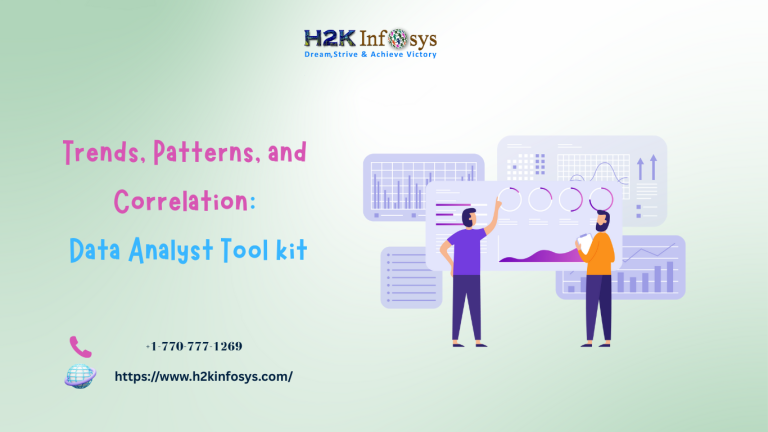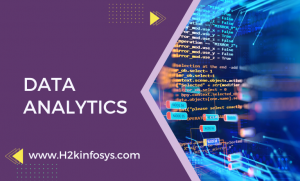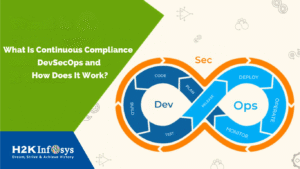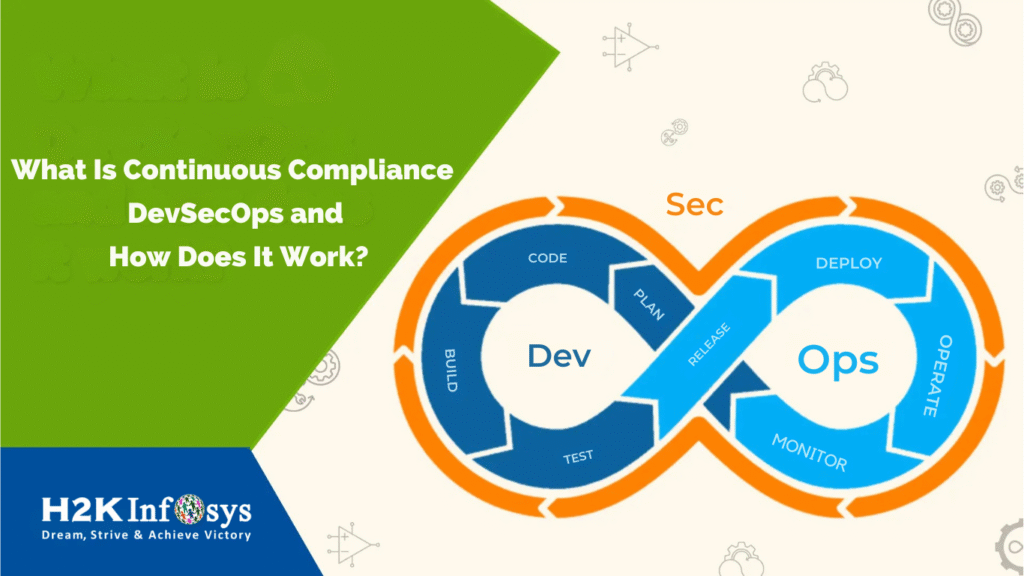Introduction:
In today’s digital-first world, every click, purchase, and interaction generates data. But raw data on its own is like crude oil; it has little value unless refined. That’s where the Data Analyst Toolkit comes in. Equipped with methods like trends, patterns, and correlation analysis, this toolkit helps professionals transform data into actionable insights.
Imagine you’re working at an e-commerce company. Millions of rows of sales data arrive daily. Without the ability to spot rising trends, detect hidden patterns, or identify critical correlations, those numbers remain meaningless. With these skills, however, you can forecast seasonal sales, discover customer behaviors, and link marketing efforts to revenue.
Whether you’re pursuing a data analytics certification, preparing for a Google Data Analytics certification, or looking into the best data analytics courses, mastering this toolkit is essential. At H2K Infosys, we empower learners to build a career-ready Data Analyst Toolkit through structured data analytics training and real-world projects.
The Anatomy of a Data Analyst Toolkit
A Data Analyst Toolkit is not just software or code it’s a combination of methods, practices, and critical thinking skills. While tools like SQL, Python, Tableau, or Excel play a role, the real toolkit lies in how you approach problems. The three most powerful techniques every analyst needs are:
- Trends – understanding direction over time.
- Patterns – spotting repetitive behavior or anomalies.
- Correlation – linking variables to reveal relationships.
These aren’t abstract theories; they’re practical components of every Online course data analytics. Let’s explore them deeply.
Trends – Seeing the Bigger Picture
A trend is simply the overall direction in which data points move over time.
- Example in Business: Sales revenue might show a rising trend over five years, interrupted by seasonal dips during off-peak months.
- Analytical Tools: Line graphs, moving averages, and time-series forecasting models such as ARIMA.
- Practical Application: A marketing team could use trend analysis to allocate budgets more effectively, ensuring campaigns align with high-demand periods.
Why it belongs in the Data Analyst Toolkit: Trends empower businesses to anticipate the future instead of reacting to the past.
Case Example: Netflix uses trend analysis to predict what type of shows audiences will binge-watch, guiding their billion-dollar content investments.
Patterns – Unlocking Recurrence and Predictability
Patterns are repeated data behaviors. They can be seasonal, cyclic, or customer-driven.
- Example in Business: Retail companies notice a recurring pattern of high shopping activity during Black Friday sales.
- Analytical Tools: Clustering, segmentation, and data mining techniques.
- Practical Application: Energy companies use pattern recognition to predict peak usage times, ensuring grid stability.
Why it belongs in the Data Analyst Toolkit: Recognizing patterns allows businesses to prepare in advance whether it’s stocking products, hiring seasonal staff, or preparing for high website traffic.
Case Example: Amazon’s recommendation engine uses pattern analysis of past customer behavior to suggest products, significantly boosting revenue.
Correlation – The Relationship Finder
Correlation measures how strongly two variables move together.
- Positive Correlation: As one increases, the other increases (e.g., ad spend vs. sales).
- Negative Correlation: As one increases, the other decreases (e.g., fuel efficiency vs. engine size).
- No Correlation: No predictable movement.
- Example in Business: Retailers may find a positive correlation between promotions on social media and website conversions.
- Analytical Tools: Scatter plots, Pearson’s correlation coefficient, and regression models.
Why it belongs in the Data Analyst Toolkit: Correlation separates assumptions from facts. Business leaders can make evidence-backed decisions instead of guesses.
Case Example: Hospitals use correlation analysis to identify how lifestyle factors impact patient outcomes, leading to personalized care plans.

Building the Data Analyst Toolkit Step-by-Step
For students enrolled in a Google Data Analytics course or those completing an online data analytics certificate, the toolkit-building journey follows these practical steps:
Step 1: Data Collection and Cleaning
- Remove duplicates, handle missing values, and ensure consistency.
- Example: Cleaning a messy dataset of customer transactions before analysis.
Step 2: Visualization
- Use Tableau, Power BI, or Python visualization libraries.
- Example: Plotting a trend line of revenue growth across quarters.
Step 3: Pattern Discovery
- Apply clustering algorithms to group similar customer behaviors.
- Example: Separating “frequent buyers” from “occasional shoppers.”
Step 4: Correlation Analysis
- Calculate correlation coefficients between metrics.
- Example: Identifying whether social media engagement correlates with new sign-ups.
Step 5: Communicate Insights
- Translate technical results into business recommendations.
- Example: Advising a retailer to increase promotions during specific months based on detected patterns.
By practicing these steps in data analytics courses for beginners, learners transform classroom knowledge into job-ready expertise.
Real-World Case Studies – The Tool kit in Action
Case 1: Healthcare
A hospital system applied correlation analysis from its Data Analyst Toolkit to link patient recovery rates with treatment protocols. The result: a 25% improvement in outcomes.
Case 2: Retail
A retailer spotted patterns in abandoned cart behavior and designed email reminders. Result: conversion rates improved by 15%.
Case 3: Finance
Banks use trend and correlation analysis to forecast loan defaults, reducing risk exposure by millions annually.
These real-world applications highlight why certifications like the Google Data Analytics certification focus heavily on toolkit-driven problem-solving.
Enhancing Your Data Analyst Toolkit with Certifications
Certifications serve as a structured path to expand your toolkit:
- Google Data Analytics Certification: Ideal for beginners. Covers everything from spreadsheets to SQL.
- Online Data Analytics Certificate: Flexible for professionals balancing work and study.
- Data Analyst Certification Online: Recognized credentials to showcase on resumes and LinkedIn.
- Best Data Analytics Courses: Hands-on, project-oriented training that strengthens practical application.
- Data Analytics Course Near Me: Blends local networking with structured learning.
Every program you choose should focus on strengthening your Data Analyst Toolkit with practical, applied skills.
Why Choose H2K Infosys to Build Your Tool kit
At H2K Infosys, our data analytics training is designed with one mission: to help you master your Data Analyst Toolkit.
- Practical Projects: Work on industry simulations, from retail forecasting to healthcare analytics.
- Career Placement Support: Interview prep and resume building after completing your data analyst certification online.
- Beginner-Friendly Learning: Courses structured as data analytics courses for beginners, ensuring step-by-step guidance.
- Flexible Formats: Choose between live instructor-led sessions or self-paced online courses in data analytics.
By enrolling, you not only gain skills, you gain confidence and career opportunities.
The Future of Analytics and the Expanding Toolkit
The future of analytics is shaped by artificial intelligence and machine learning. But no matter how advanced tools become, the foundation of every Data Analyst Toolkit will remain:
- Trends for forecasting.
- Patterns for behavior understanding.
- Correlation for relationship discovery.
Emerging technologies like predictive AI and automated machine learning will only amplify the importance of these three pillars. Analysts who master them today will thrive tomorrow.
Key Takeaways
- Trends, patterns, and correlation are the core of every Data Analyst Toolkit.
- These skills transform raw data into insights that businesses act upon.
- Certifications like the Google Data Analytics certification ensure practical learning.
- Real-world applications from retail to healthcare prove the power of these techniques.
- H2K Infosys offers structured data analytics training that equips you with a career-ready toolkit.
Conclusion: Your Success Begins with the Right Toolkit
Data analysis is not just about crunching numbers; it’s about delivering insights that matter. Trends show direction, patterns uncover recurrence, and correlation builds connections. Together, they form the ultimate Data Analyst Toolkit.
Enroll in H2K Infosys’ Data Analytics programs today and build the complete Data Analyst Toolkit that employers value. Start your journey to a high-demand career now.

























